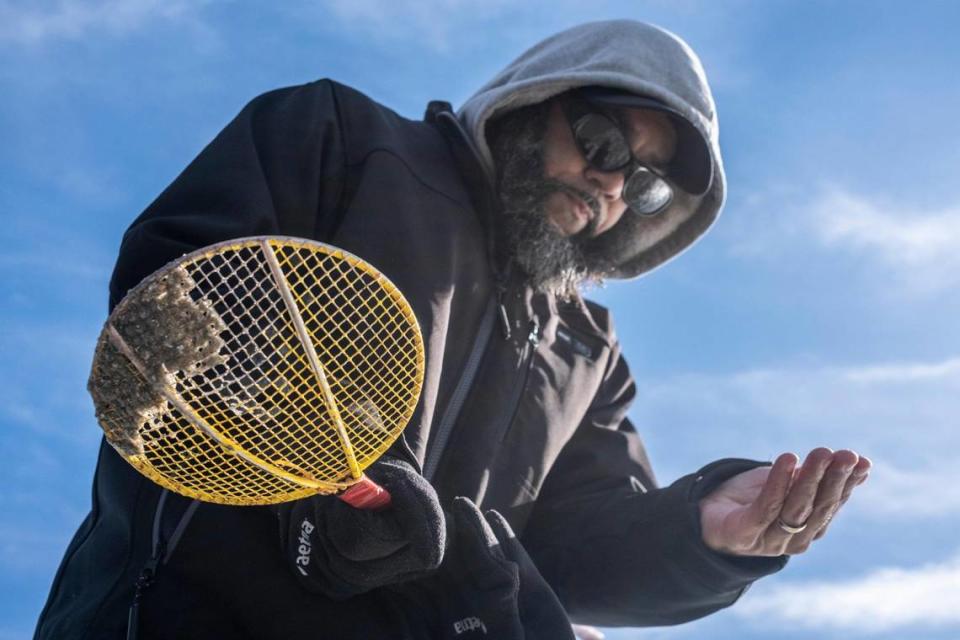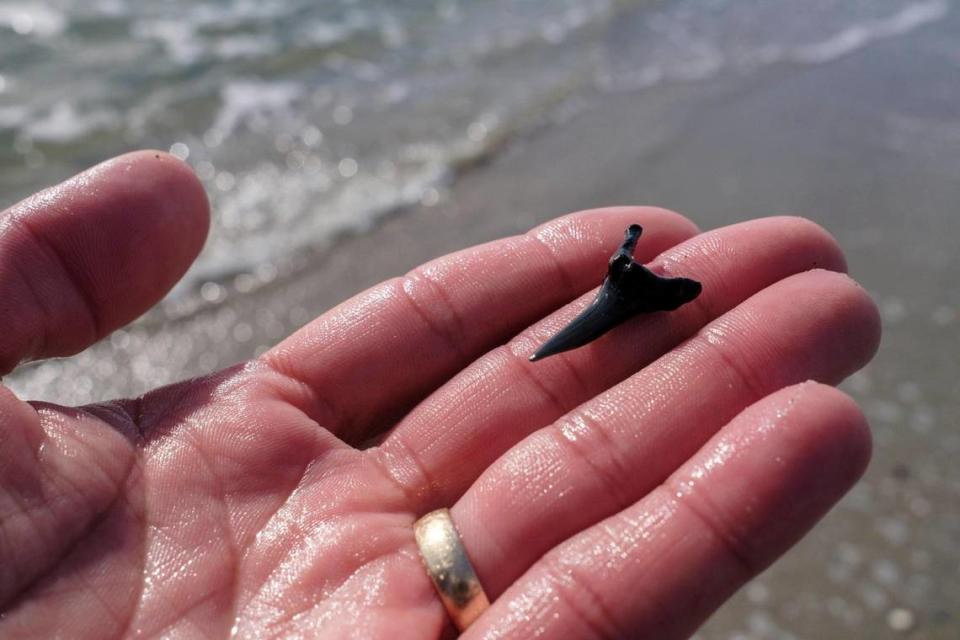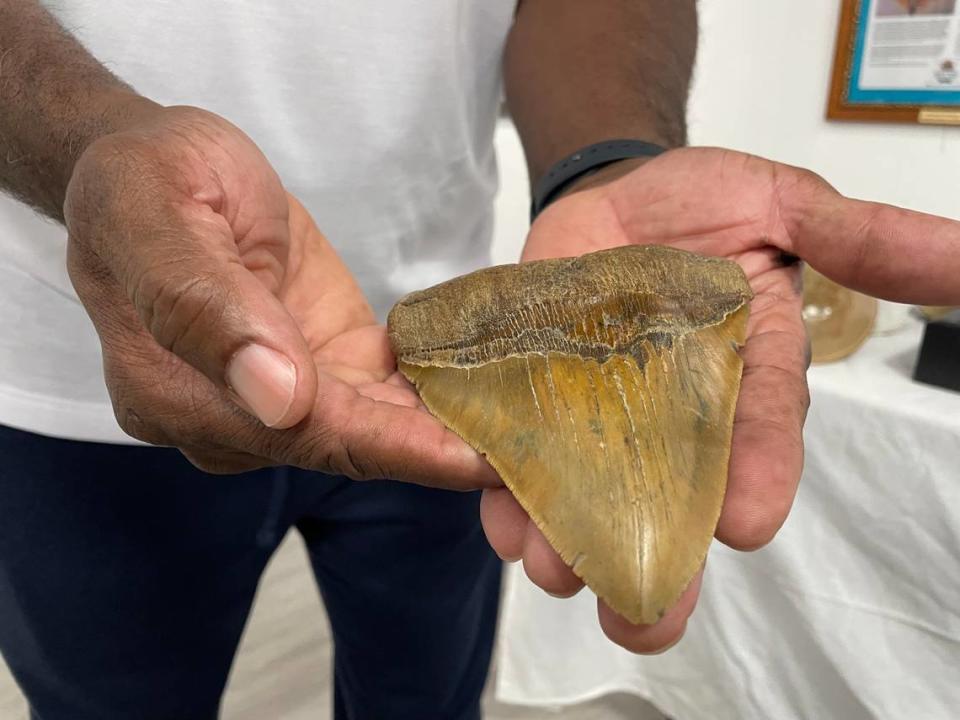Myrtle Beach area great spot for finding sharks’ teeth. Shark tooth hunter offers his tips
On a cold Monday morning near the Springmaid Pier in Myrtle Beach, ocean waves are lapping onto Charles Shelton Jr.’s black, rubber boots as he dips his metal scoop into the sand and examines its contents in the water.
After just a few scoops, he finds what he is looking for. There among the broken bits of shell and wet sand is a black, shiny triangular shark tooth. Shelton turns the tooth over in his hand and declares that it’s a tooth from a Dusky shark.

A little later, he found teeth from a Sand Tiger and a Makko shark. And while these aren’t the big finds that he’s really looking for – Great White, Megalodon and Carolina Creams – they are the kind that can bring excitement to a novice hunter.
Shelton is an expert shark tooth hunter. He offers his knowledge and expertise on finding sharks’ teeth and fossils during tours and educational talks, including a most recent talk at the North Myrtle Beach Historical Museum where it was standing room only for those wanting to hear his tips and tricks. He also manages the Myrtle Beach Shark Teeth Facebook page, which currently has more than 41,000 members.
Hunting for sharks’ teeth is hugely popular along the Grand Strand. The shiny, triangular black teeth have a deep attraction for those who comb the beach hoping to find them.
A shark loses between 20,000 to 30,000 teeth, Shelton said. And with about 60 mouths of different shark species in the Myrtle Beach area, it provides a “wonderful opportunity” for anyone to find teeth, he said.
Some of the more common shark species are Dusky, Tiger, Spinner, Black Tip, Bull and Great White.
South Carolina and North Carolina are the better two states to find teeth on the East Coast, Shelton said. The No. 1 place is Venice Beach, Florida, which is known as the “shark tooth capital of the world.”
Here’s how to find those teeth
The Myrtle Beach area is a great place to find sharks’ teeth. Wilmington, North Carolina, to Charleston, South Carolina, is considered a shark lagoon where many sharks can be found, Shelton said.
Shelton considers the wind, tides and rain when he goes to a beach. He also doesn’t spend a lot of time at one beach if it’s not producing. He may, at times, visit up to four beaches a day in his search, he said. For him, he goes early and is usually finished by 5 or 7 a.m.
Moving is the key to finding teeth, he said. He starts by looking at the beach and where the surf has been, finding the highest tide line and the thrash line. That’s where the greatest number of shells have been left. The more shells, the greater chance of finding shark’s teeth, Shelton said.
However, “just because you find a lot of shells, doesn’t mean you’ll find a lot of teeth,” Shelton said. “It’s really a gamble.”

Chances are, you are probably walking over the teeth because you may think it’s a rock or something not worth collecting, Shelton said.
“Don’t be afraid to pick up something you don’t think is a tooth,” he said.
Shelton said the area around Second Avenue Pier in Myrtle Beach has a lot of fossils, especially because of the rock bed that is there.
Here are some of Shelton’s tips for finding teeth:
Ultimately, look for a shiny, black, triangular shape in the sand.
Come on a dry day.
Winter at lowest tide is a better time to look.
Know your area and look for the thrash line, which is where the shells have gathered after high tide.
Switch up your beaches.
If you find a tooth, keep it, even if you don’t know what it is.
Give a beach time after dredging so that the sand can be leveled out by the ocean. While dredging can bring up new things, it ultimately will cover up what is already there with layers of sand.
Go early.
Shelton searches with his face facing forward and the ocean behind him. On sunny days, he tries to angle his shadow along the area that he is searching.
A wet tooth looks different than a dry tooth. A Caroline Cream, for instance, is tan when wet and white when dry. To find one of these, you will have to dig as they are often not found on the sand.
And for the coveted megalodon teeth, they have been found on beaches. However, the tooth is usually found in the inlet of a river, Shelton said. In order to find those, “you have to go inland or diving,” he said.
Shelton knows that hunting can become competitive, which results in some people taking things too far. He wants people to know that the “beach is not ours. The beach is everybody’s.”
When it comes to finding shark teeth, Shelton’s biggest tip is to find your own way of searching.
“It’s what works best for you,” he said. “You just have to know where to look.”
How he got started
The 40-year-old has been hunting for shark teeth and fossils for more than 35 years. He got started by competing with his mother on who could find the most as they came to Myrtle Beach for vacation every year. The West Virginia family finally made the permanent move to the Myrtle Beach area a little more than a year ago.
Shelton focuses on his education work and Facebook page full-time. He learned by reading books and talking with “old timers” about their tips and tricks. At the time he first got started, there wasn’t the internet to help with his finds, which now reach into the hundreds.
At his North Myrtle Beach talk, jars of teeth and different fossils and teeth enclosed in glass display cases lined the tables. One of those great finds is a giant megalodon tooth.

Since Shelton wasn’t born on the coast, he tried to get everything he could in the week that he was in Myrtle Beach.
Now, he has people turning to him for advice. He started the Facebook page about seven years ago. During the peak season of beach visitors and vacationers, he will see about 1,500 followers a week. He approves about that many posts every day.
“I never would’ve thought it would be this large,” Shelton said. “It’s wild. It’s really humbling.”

